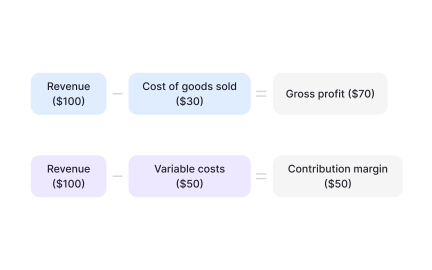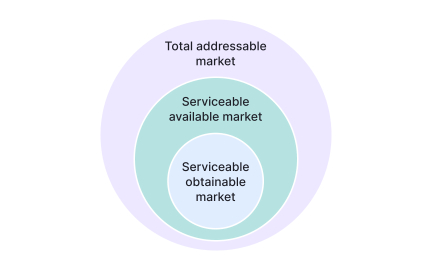Total Addressable Market (TAM)
Total addressable market (TAM) is the total revenue opportunity available if a product achieved full market adoption across its segment.
What is Total Addressable Market?
Your business strategy and investment decisions lack foundation because you don't understand the actual size of market opportunities, leading to unrealistic revenue projections and resource allocation that doesn't match market potential and competitive reality.
Most companies estimate market size using hopeful assumptions and industry reports without rigorous analysis of actual customer segments and purchasing behavior, missing crucial insights about realistic business potential and competitive positioning requirements.
Total addressable market (TAM) is the comprehensive revenue opportunity available for a product or service if it achieved 100% market share, providing strategic foundation for business planning, investment decisions, and realistic goal setting based on market constraints and opportunities.
Companies with accurate TAM analysis achieve 50% better strategic planning, 40% more realistic growth projections, and significantly improved investor confidence because business cases are grounded in market reality rather than optimistic assumptions about unlimited opportunity.
Think about how successful startups use rigorous market analysis to convince investors and guide product development priorities, or how established companies use TAM evaluation to assess expansion opportunities and competitive threats across different market segments.
Why Total Addressable Market Matters for Strategic Planning
Your business planning operates in fantasy because market size assumptions don't reflect actual customer willingness to pay or competitive dynamics, leading to strategies that ignore market constraints and resource requirements for meaningful market share capture.
The cost of incorrect TAM assessment compounds through every strategic decision based on market size. You waste resources pursuing markets that can't support business objectives, miss opportunities in underestimated markets, and lose credibility when projections don't match achievable results.
What accurate total addressable market analysis delivers:
More realistic business planning and goal setting because TAM analysis reveals actual market constraints and opportunities rather than assuming unlimited growth potential without competitive and customer reality consideration.
When market size is understood accurately, business strategies can be designed to capture meaningful market share rather than pursuing impossibly large percentages of imaginary markets.
Better investment and resource allocation decisions through understanding which markets justify development investment and which opportunities are too small to generate adequate returns on strategic initiatives and competitive efforts.
Enhanced credibility with investors and stakeholders because TAM analysis demonstrates strategic thinking and market awareness that builds confidence in business leadership and planning capabilities.
Improved competitive positioning and market entry strategy as TAM research reveals market segmentation, customer behavior, and competitive dynamics that inform effective market approach and differentiation strategies.
Stronger product development prioritization through understanding which customer segments and use cases represent the largest addressable opportunities within realistic competitive and market constraints.
Advanced Total Addressable Market Analysis
Once you've established basic TAM calculation capabilities, implement sophisticated market analysis and strategic application approaches.
Segmented TAM Analysis and Opportunity Prioritization: Break down total addressable market by customer segments, geographic regions, and use cases rather than treating market as homogeneous opportunity without strategic segmentation.
Dynamic TAM Modeling and Market Evolution: Create TAM models that account for market growth, technology changes, and competitive evolution rather than static market size calculations that don't reflect market development over time.
Competitive TAM Positioning and Share Analysis: Evaluate market opportunity relative to competitive strengths and positioning rather than just total market size without consideration of realistic market share potential.
TAM Integration with Business Model and Unit Economics: Connect market size analysis to business model viability and customer acquisition economics rather than just market opportunity without profitability and scaling consideration.
Step 1: Define Product Category and Customer Segments Clearly (Week 1)
Establish specific boundaries for your market analysis including product definition, customer types, geographic scope, and competitive landscape rather than using vague market categories that don't reflect actual business opportunity.
This creates TAM foundation based on specific business opportunity rather than broad industry categories that might not represent achievable market share or realistic customer segments for your particular offering.
Step 2: Research Customer Population and Purchasing Behavior (Week 1-2)
Gather data about potential customer numbers, spending patterns, purchase frequency, and decision-making processes rather than just demographic information that might not predict actual purchasing behavior and market participation.
Focus research on customers who would realistically consider and purchase your type of product rather than entire population segments that might not represent genuine market opportunity.
Step 3: Apply Top-Down and Bottom-Up Analysis Methods (Week 2)
Use both industry-level market size data and customer-level purchasing analysis to validate market size estimates rather than relying on single methodology that might miss important market dynamics or customer behavior patterns.
Balance comprehensive market analysis with practical applicability to ensure TAM calculations inform strategic decisions rather than just providing interesting market data without business actionability.
Step 4: Assess Market Accessibility and Competitive Constraints (Week 2-3)
Evaluate realistic market share potential based on competitive dynamics, customer acquisition requirements, and distribution challenges rather than assuming total market availability without competitive and operational barriers consideration.
Step 5: Validate TAM Estimates Through Multiple Data Sources (Week 3)
Cross-reference market size calculations using different data sources and methodologies rather than accepting initial estimates without verification that could reveal calculation errors or market assumption problems.
This ensures TAM analysis provides reliable strategic foundation rather than just numerical estimates that might not withstand scrutiny from investors, stakeholders, or competitive market reality.
If TAM calculations don't improve strategic planning, examine whether market definitions match actual business opportunity rather than theoretical market categories that don't reflect achievable customer segments.
Uber's Transportation Market Redefinition
Uber expanded TAM analysis beyond traditional taxi markets to include all urban transportation spending, revealing opportunity that supported massive valuation and aggressive expansion strategy across global markets and transportation categories.
Results: Successful global expansion, investor confidence in large market opportunity, and strategic framework for diversification into delivery, freight, and autonomous vehicle development based on comprehensive transportation TAM analysis.
Salesforce's CRM Market Expansion
Salesforce built business strategy around expanding CRM market definition to include all customer relationship technology spending, enabling platform growth that created larger market opportunity than traditional CRM category limitations.
Their TAM vision enabled successful platform strategy and acquisition approach that expanded addressable market through comprehensive customer relationship technology ecosystem development.
The Problem: TAM calculations that include customers who would never realistically purchase your product type, creating inflated market size estimates that don't support strategic planning or investor credibility.
The Fix: Focus TAM analysis on customers who have demonstrated willingness to purchase similar products and have budget allocation for your product category rather than entire demographic populations without purchasing behavior validation.
The Problem: Market size analysis that ignores competitive dynamics and assumes easy market share capture without considering competitive advantages required for meaningful market penetration.
The Fix: Include competitive analysis and market share realism in TAM evaluation rather than just total opportunity without assessment of competitive requirements for market capture success.
The Problem: TAM estimates based on industry reports and generic data rather than specific analysis of your customer segments and competitive positioning within actual market dynamics.
The Fix: Conduct primary research and specific market analysis rather than relying only on published industry data that might not reflect your particular market opportunity and competitive context.
Create total addressable market analysis that supports realistic strategic planning rather than just impressive market size numbers that don't reflect achievable business opportunity and competitive reality.
What You'll Need: Market research resources, competitive analysis capabilities, and 3-4 weeks for comprehensive TAM analysis and validation across multiple methodologies.
Week 1: Market definition and customer segment identification
Week 2: Data collection and purchasing behavior analysis
Week 3: TAM calculation using multiple methods and competitive assessment
Week 4: Validation and strategic application planning
First step you can take today:
Define exactly what customer problem your product solves, then estimate how many businesses or people have that problem and currently spend money trying to solve it.
Success metrics to track:
Strategic planning accuracy, investor presentation credibility, market entry success rates, and business goal achievement through realistic market size foundation.
Your total addressable market analysis should make business opportunity feel realistic and achievable rather than based on optimistic assumptions that ignore competitive dynamics and customer behavior constraints.
Recommended resources
Courses

Product Discovery

Product Analytics






